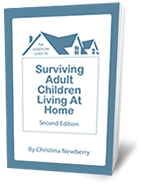With Americans of all ages feeling the effects of the economic crisis and the plummeting housing market, mutigenerational households may become more prevalent in the coming years. AARP Bulletin, the go-to news source for 50+ America, recently released the results of an exclusive new survey that looks at housing trends and how the economy may be impacting adults’ living situations. More than 1,000 people age 18 and older were surveyed about who they live with, how likely it is that they will need to move in with another family member or friend, and how comfortable they would be living with additional friends or family members if that would become necessary.
The results show a direct relation between a loss of income and young adults who are moving back home with their parents after a period of independence. Additional key findings include:
Multigenerational Housing: 11% of people age 50+ live with their grandchildren or their parents.
“Boomerang Adults”: 11% of people age 35-44 report living with their parents or their in-laws.
Why People Move: 34% of people who said that they would likely have to move in with family or friends said that it would be due to a loss of income.
“The recession is having an impact on people of all ages, and the effects are starting to be felt at home,” said Jim Toedtman, Vice President and Editor of AARP Bulletin. “We see more people living under the same roof as their parents and their adult children. As Americans face tougher economic conditions, we’ll likely see more of this.”
Results of AARP Bulletin’s Multigenerational Housing survey suggest that as jobs continue to disappear and the foreclosure crisis continues, millions of 50+ Americans will be living with their adult children and grandchildren in multigenerational homes.
Multigenerational Housing and Boomerang Adults
The survey found that that 4% of people age 50+ are currently living with their grandchildren. Results also showed 33% of respondents age 18-49 live with parents or in-laws. A further analysis of this group showed 11% of respondents age 35-44 live with parents or in-laws. Of those respondents, 9% report living with their parents and 2% reporting living with their in-laws.
Likelihood of Moving in With Others
When asked how likely it is that they may need to move in with family members or friends or have family members or friends move in with them, 15% said that it was likely. Among those who thought it would be likely, the largest percentage — about one-third (34%) — said it would be due to a loss of income, 19% said that it would be due to a change in job status and 8% cited home foreclosure as the reason.
Results also showed that respondents between 18 and 34 are more likely than older respondents to have already made such a move (20% vs. 9% for those age 35-44; 8% for those 45-54; 9% for those 55-64; and 7% for those 65+).
Comfort in Living with Additional Friends or Family Members
Roughly one in seven (14%) respondents said they would not be very comfortable, and nearly three in ten (29%) would not be at all comfortable living with additional friends or family members. In contrast, 14% said they would be extremely comfortable and 14% said they would be very comfortable if such a change in housing became necessary. More than a quarter (27%) of respondents said they would be somewhat comfortable with such an arrangement.
Additional information can be found in the March 2009 issue of AARP Bulletin at http://www.aarp.org/research/housing-mobility/affordability/multigen_housing.html.
AARP Bulletin’s Multigenerational Housing Survey was conducted by International Communications Research, Inc. (ICR) in January 2009. A short telephone survey among a nationally representative sample of adults ages 18 and older was taken to learn more about housing patterns and their options about how their own housing situation may change in the next year. The total sample consisted of 1,002 adults who are 18 and older.
Source: AARP/PRNewswire

